�
This page intentionally left blank
FMTOC.indd Page i 12/24/10 9:26:24 PM users-133
FMTOC.indd Page i 12/24/10 9:26:24 PM users-133
/Users/users-133/Desktop/Ramakant_04.05.09/WB00113_R1:JWCL170/New
/Users/users-133/Desktop/Ramakant_04.05.09/WB00113_R1:JWCL170/New
Microsoft® Official Academic Course
Networking Fundamentals,
Exam 98-366
�
FMTOC.indd Page ii 12/24/10 9:26:25 PM users-133
FMTOC.indd Page ii 12/24/10 9:26:25 PM users-133
/Users/users-133/Desktop/Ramakant_04.05.09/WB00113_R1:JWCL170/New
/Users/users-133/Desktop/Ramakant_04.05.09/WB00113_R1:JWCL170/New
Credits
EDITOR
DIRECTOR OF SALES
DIRECTOR OF MARKETING
MICROSOFT SENIOR PRODUCT MANAGER
EDITORIAL PROGRAM ASSISTANT
CONTENT MANAGER
SENIOR PRODUCTION EDITOR
CREATIVE DIRECTOR
COVER DESIGNER
TECHNOLOGY AND MEDIA
Bryan Gambrel
Mitchell Beaton
Chris Ruel
Merrick Van Dongen of Microsoft Learning
Jennifer Lartz
Micheline Frederick
Kerry Weinstein
Harry Nolan
Jim O’Shea
Tom Kulesa/Wendy Ashenberg
Cover photo: Credit: © Design Pics/Eryk Jaegermann/Getty Images, Inc.
This book was set in Garamond by Aptara, Inc. and printed and bound by Bind Rite Graphics.
The cover was printed by Phoenix Color.
Copyright © 2011 by John Wiley & Sons, Inc. All rights reserved.
No part of this publication may be reproduced, stored in a retrieval system or transmitted in any form or by any means,
electronic, mechanical, photocopying, recording, scanning or otherwise, except as permitted under Sections 107 or 108
of the 1976 United States Copyright Act, without either the prior written permission of the Publisher, or authorization
through payment of the appropriate per-copy fee to the Copyright Clearance Center, Inc. 222 Rosewood Drive, Danvers,
MA 01923, website www.copyright.com. Requests to the Publisher for permission should be addressed to the Permissions
Department, John Wiley & Sons, Inc., 111 River Street, Hoboken, NJ 07030-5774, (201)748-6011, fax (201)748-6008,
website http://www.wiley.com/go/permissions.
Microsoft, ActiveX, Excel, InfoPath, Microsoft Press, MSDN, OneNote, Outlook, PivotChart, PivotTable, PowerPoint,
SharePoint, SQL Server, Visio, Visual Basic, Visual C#, Visual Studio, Windows, Windows 7, Windows Mobile, Windows
Server, and Windows Vista are either registered trademarks or trademarks of Microsoft Corporation in the United States and/
or other countries. Other product and company names mentioned herein may be the trademarks of their respective owners.
The example companies, organizations, products, domain names, e-mail addresses, logos, people, places, and events
depicted herein are fictitious. No association with any real company, organization, product, domain name, e-mail address,
logo, person, place, or event is intended or should be inferred.
The book expresses the author’s views and opinions. The information contained in this book is provided without any
express, statutory, or implied warranties. Neither the authors, John Wiley & Sons, Inc., Microsoft Corporation, nor their
resellers or distributors will be held liable for any damages caused or alleged to be caused either directly or indirectly by
this book.
ISBN 978-0-470-90183-0
Printed in the United States of America
10 9 8 7 6 5 4 3 2 1
call the MOAC Toll-Free Number: 1+(888) 764-7001 (U.S. & Canada only)
www.wiley.com/college/microsoft or
�
FMTOC.indd Page iii 12/24/10 9:26:25 PM users-133
FMTOC.indd Page iii 12/24/10 9:26:25 PM users-133
/Users/users-133/Desktop/Ramakant_04.05.09/WB00113_R1:JWCL170/New
/Users/users-133/Desktop/Ramakant_04.05.09/WB00113_R1:JWCL170/New
Foreword from the Publisher
Wiley’s publishing vision for the Microsoft Official Academic Course series is to provide
students and instructors with the skills and knowledge they need to use Microsoft technol-
ogy effectively in all aspects of their personal and professional lives. Quality instruction is
required to help both educators and students get the most from Microsoft’s software tools and
to become more productive. Thus our mission is to make our instructional programs trusted
educational companions for life.
To accomplish this mission, Wiley and Microsoft have partnered to develop the highest quality
educational programs for Information Workers, IT Professionals, and Developers. Materials cre-
ated by this partnership carry the brand name “Microsoft Official Academic Course,” assuring
instructors and students alike that the content of these textbooks is fully endorsed by Microsoft,
and that they provide the highest quality information and instruction on Microsoft products.
The Microsoft Official Academic Course textbooks are “Official” in still one more way—they
are the officially sanctioned courseware for Microsoft IT Academy members.
The Microsoft Official Academic Course series focuses on workforce development. These
programs are aimed at those students seeking to enter the workforce, change jobs, or embark
on new careers as information workers, IT professionals, and developers. Microsoft Official
Academic Course programs address their needs by emphasizing authentic workplace scenarios
with an abundance of projects, exercises, cases, and assessments.
The Microsoft Official Academic Courses are mapped to Microsoft’s extensive research and
job-task analysis, the same research and analysis used to create the Microsoft Technology
Associate (MTA) and Microsoft Certified Information Technology Professional (MCITP)
exams. The textbooks focus on real skills for real jobs. As students work through the projects
and exercises in the textbooks they enhance their level of knowledge and their ability to apply
the latest Microsoft technology to everyday tasks. These students also gain resume-building cre-
dentials that can assist them in finding a job, keeping their current job, or in furthering their
education.
The concept of life-long learning is today an utmost necessity. Job roles, and even whole
job categories, are changing so quickly that none of us can stay competitive and productive
without continuously updating our skills and capabilities. The Microsoft Official Academic
Course offerings, and their focus on Microsoft certification exam preparation, provide a
means for people to acquire and effectively update their skills and knowledge. Wiley sup-
ports students in this endeavor through the development and distribution of these courses as
Microsoft’s official academic publisher.
Today educational publishing requires attention to providing quality print and robust elec-
tronic content. By integrating Microsoft Official Academic Course products, WileyPLUS, and
Microsoft certifications, we are better able to deliver efficient learning solutions for students
and teachers alike.
Bonnie Lieberman
General Manager and Senior Vice President
call the MOAC Toll-Free Number: 1+(888) 764-7001 (U.S. & Canada only)
| iii
www.wiley.com/college/microsoft or
�
FMTOC.indd Page iv 12/30/10 8:54:47 PM users-133
FMTOC.indd Page iv 12/30/10 8:54:47 PM users-133
/Users/users-133/Desktop/Ramakant_04.05.09/WB00113_R1:JWCL170/New
/Users/users-133/Desktop/Ramakant_04.05.09/WB00113_R1:JWCL170/New
Preface
Welcome to the Microsoft Official Academic Course (MOAC) program for Networking
Fundamentals. MOAC represents the collaboration between Microsoft Learning and John
Wiley & Sons, Inc. publishing company. Microsoft and Wiley teamed up to produce a series
of textbooks that deliver compelling and innovative teaching solutions to instructors and
superior learning experiences for students. Infused and informed by in-depth knowledge
from the creators of Microsoft products, and crafted by a publisher known worldwide for the
pedagogical quality of its products, these textbooks maximize skills transfer in minimum time.
Students are challenged to reach their potential by using their new technical skills as highly
productive members of the workforce.
Because this knowledge base comes directly from Microsoft, creator of the Microsoft Certified
IT Professional (MCITP), Microsoft Certified Technology Specialist (MCTS), and Microsoft
Certified Professional (MCP) exams (www.microsoft.com/learning/certification), you are sure to
receive the topical coverage that is most relevant to students’ personal and professional success.
Microsoft’s direct participation not only assures you that MOAC textbook content is accurate
and current; it also means that students will receive the best instruction possible to enable their
success on certification exams and in the workplace.
■ The Microsoft Official Academic Course Program
The Microsoft Official Academic Course series is a complete program for instructors and institutions
to prepare and deliver great courses on Microsoft software technologies. With MOAC, we recognize
that, because of the rapid pace of change in the technology and curriculum developed by Microsoft,
there is an ongoing set of needs beyond classroom instruction tools for an instructor to be ready to
teach the course. The MOAC program endeavors to provide solutions for all these needs in a sys-
tematic manner in order to ensure a successful and rewarding course experience for both instructor
and student—technical and curriculum training for instructor readiness with new software releases;
the software itself for student use at home for building hands-on skills, assessment, and validation of
skill development; and a great set of tools for delivering instruction in the classroom and lab. All are
important to the smooth delivery of an interesting course on Microsoft software, and all are pro-
vided with the MOAC program. We think about the model below as a gauge for ensuring that we
completely support you in your goal of teaching a great course. As you evaluate your instructional
materials options, you may wish to use the model for comparison purposes with available products.
iv |
call the MOAC Toll-Free Number: 1+(888) 764-7001 (U.S. & Canada only)
www.wiley.com/college/microsoft or
�
FMTOC.indd Page v 12/24/10 9:26:26 PM users-133
FMTOC.indd Page v 12/24/10 9:26:26 PM users-133
/Users/users-133/Desktop/Ramakant_04.05.09/WB00113_R1:JWCL170/New
/Users/users-133/Desktop/Ramakant_04.05.09/WB00113_R1:JWCL170/New
Illustrated Book Tour
■ Pedagogical Features
Pedagogical Features
The MOAC textbook for Networking Fundamentals is designed to cover all the learning
objectives for that MTA exam 98-366, which is referred to as its “objective domain.” The
Microsoft Technology Associate (MTA) exam objectives are highlighted throughout the
textbook. Many pedagogical features have been developed specifically for Microsoft Official
Academic Course programs.
Presenting the extensive procedural information and technical concepts woven throughout the
textbook raises challenges for the student and instructor alike. The Illustrated Book Tour that
follows provides a guide to the rich features contributing to Microsoft Official Academic Course
program’s pedagogical plan. Following is a list of key features in each lesson designed to
prepare students for success as they continue in their IT education, on the certification
exams, and in the workplace:
Each lesson begins with a Lesson Skill Matrix. More than a standard list of learning
objectives, the Domain Matrix correlates each software skill covered in the lesson to the
specific exam objective domain.
Concise and frequent Step-by-Step instructions teach students new features and provide
an opportunity for hands-on practice. Numbered steps give detailed, step-by-step
instructions to help students learn software skills.
Illustrations: Screen images provide visual feedback as students work through the
exercises. The images reinforce key concepts, provide visual clues about the steps, and
allow students to check their progress.
Key Terms: Important technical vocabulary is listed with definitions at the beginning of
the lesson. When these terms are used later in the lesson, they appear in bold italic type
and are defined. The Glossary contains all of the key terms and their definitions.
Engaging point-of-use Reader Aids, located throughout the lessons, tell students why
this topic is relevant (The Bottom Line), provide students with helpful hints (Take Note).
Reader Aids also provide additional relevant or background information that adds value
to the lesson.
Certification Ready features throughout the text signal students where a specific
certification objective is covered. They provide students with a chance to check their
understanding of that particular MTA objective and, if necessary, review the section
of the lesson where it is covered. MOAC offers complete preparation for MTA
certification.
End-of-Lesson Questions: The Knowledge Assessment section provides a variety of
multiple-choice, true-false, matching, and fill-in-the-blank questions.
End-of-Lesson Exercises: Competency Assessment case scenarios, Proficiency Assessment
case scenarios, and Workplace Ready exercises are projects that test students' ability to
apply what they've learned in the lesson.
call the MOAC Toll-Free Number: 1+(888) 764-7001 (U.S. & Canada only)
www.wiley.com/college/microsoft or
| v
�
FMTOC.indd Page vi 12/29/10 8:22:55 AM user-s146
FMTOC.indd Page vi 12/29/10 8:22:55 AM user-s146
/Users/user-s146/Desktop/Merry_X-Mas/New
/Users/user-s146/Desktop/Merry_X-Mas/New
vi | Illustrated Book Tour
■ Lesson Features
c02DefiningNetworkswiththeOSIMod30 Page 30 12/23/10 8:04:25 PM f-392
/Users/f-392/Desktop/Nalini 23.9/ch05
2
LESSON
Defining Networks
with the OSI Model
O B J E C T I V E D O M A I N M A T R I X
SKILLS/CONCEPTS
MTA EXAM OBJECTIVE
MTA EXAM OBJECTIVE NUMBER
Understanding OSI Basics
Understand the OSI model.
3.1
Defining the Communications
Subnetwork
Defining the Upper OSI Layers
Defining the Communications
Subnetwork
Understand switches.
2.1
K E Y T E R M S
Address Resolution Protocol
application layer
ARP table
baseband
broadband
CAM table
communications subnetwork
data link layer (DLL)
encapsulated
encoded
inbound ports
Internet Assigned Numbers Authority (IANA)
Internet Control Message Protocol
Internet Engineering Task Force (IETF)
Internet Protocol
layer 2 switch
layer 3 switch
MAC Flood
Media Access Control (MAC) address
network layer
Open Systems Interconnection (OSI)
outbound ports
overhead
physical layer
ports
presentation layer
protocol stack
session layer
Transmission Control Protocol (TCP)
transport layer
User Datagram Protocol (UDP)
virtual LAN (VLAN)
Objective Domain Matrix
Key Terms
c01UnderstandingLocalAreaNetwork15 Page 15 12/23/10 7:52:12 PM f-392
/Users/f-392/Desktop/Nalini 23.9/ch05
Understanding Local Area Networking | 15
Generally, the connection from PCs to their switch will be either 100 Mbps or 1 Gbps. Whatever
speed you decide to use must be supported by each port of the switch, as well as by each of the
computers. In this diagram, the computers are wired to the switch. Therefore, to accomplish
gigabit network speeds, the cables used would have to be Category 5e or greater (more on types
of cabling in Lesson 3).
However, the connection from the server farm to the switch in the upper left of the figure, as
well as from the super computer to its switch, should be faster than your average PC connection.
So, if the PCs on the LAN connected at 100 Mbps, the servers might be better off connecting
at 1 Gbps; similarly, if the PCs connected at 1 Gbps, the servers should connect at 10 Gbps.
High-speed connections should also be made between the three switches and the router. Now
we are looking at a more accurate representation of a network setup for our fictitious company.
However, our network documentation is going to get much more detailed as we progress. After
all, we are only in Lesson 1.
Historically, wired networks were significantly faster than wireless networks. But now, the speed
difference between the two is much smaller due to the fact that wireless networking technology
has progressed in giant leaps over the past decade or so. A wireless local area network (WLAN)
has many advantages, the most obvious of which is the ability to roam. Here, a person with
a laptop, handheld computer, PDA, or other such device can work from anywhere. However,
wireless LANs pose many security problems, and because of this, some companies have opted
not to use them in their main offices. Figure 1-16 illustrates some wireless devices.
30
c03Understanding Wired and Wirel59 Page 59 12/23/10 8:14:56 PM f-392
/Users/f-392/Desktop/Nalini 23.9/ch05
Table 3-3
(continued)
Understanding Wired and Wireless Networks | 59
Informative
Diagrams
Figure 1-16
Wireless LAN diagram
Smart Phone
PDA
Wireless Access Point
CABLING STANDARD
MEDIUM
MAXIMUM DISTANCE
1000BASE-BX10
Single-mode fiber
10 km
10GBASE-SR
10GBASE-LR
10GBASE-LRM
10GBASE-ER
Multi-mode fiber
26–82 meters
Single-mode fiber
Multi-mode fiber
10–25 km
220 meters
Single-mode fiber
40 km
When it comes to interference, a cable itself can be its worst enemy. Generally, fiber optic
cables are not affected by EMI, because they are inherently light based, not electricity based.
Although a fiber optic cable will still produce a type of electromagnetic radiation, the cable is
not traditionally affected by EMI in the same way copper-based cables are. However, if a fiber
run is installed improperly, it can give strange results when it comes to the data signal. Exact
installation rules must be followed including proper termination, specific radii for turns,
avoiding bunching, and so on. Improper installation results in the signal becoming “bent,”
which causes data loss. Chromatic dispersion is also a factor, as opposed to attenuation on
twisted-pair cables. If the light is refracted too often, again, the signal will degrade. Fiber
optic cable in general is the most secure cable, allows for the longest runs, and offers data
transfer rates that are equal to or greater than twisted-pair cable. However, due to the com-
plexity of installation, cost, and so on, fiber optic cable is not usually a first choice for all of
the individual client computer runs. Instead, it is used for backbone connections; switch con-
nections at the top of hierarchical star topologies, and other high-bandwidth or long-distance
applications.
■ Comprehending Wireless Networks
THE BOTTOM LINE
Wireless networks are everywhere. There are wireless networks for computers, handheld
devices, wide-area connections, and more. Chances are you have used a wireless network
in the past. In order to install and troubleshoot wireless networks, you must understand
the basics of wireless communications and have knowledge of the devices, standards,
frequencies, and security methods.
Identifying Wireless Devices
CERTIFICATION READY
How do you identify
wireless devices?
1.4
Wireless devices might allow for central connectivity of client computers and handheld
devices. Or, they might offer an extension of connectivity to a pre-existing wireless network
and could be used to connect entire local area networks to the Internet. In addition, some
wireless devices can be connected directly to each other in a point-to-point fashion.
By far the most well-known wireless device is the wireless access point WAP. This device
quite often also acts as a router, firewall, and IP proxy. It allows for the connectivity of various
wireless devices such as laptops, PDAs, handheld computers, and so on. It does so by making
connections via radio waves on specific frequencies. Client computers and handheld devices
must use the same frequency in order to connect to the WAP. In the following exercise, we will
identify wireless access points, wireless network adapters, and wireless bridges and repeaters.
Tablet Computer
Laptop
The wireless access point (WAP) acts as the central connecting device for the network. Today,
such networks can consist of many types of devices other than traditional PCs, including smart
phones, PDAs, tablet computers, and micro computers. Not to mention the fact that PCs and
laptops equipped with wireless network adapters can connect to these networks as well.
Wireless networks and wired networks can co-exist. In fact, in small networks, a single device
can act as a wireless access point, switch, router, and firewall! However, larger networks will
usually have one or more separate wireless access points that connect in a wired fashion to a
network switch. Also, it’s important to note that wireless access points have a limited range.
Therefore, you might need to implement multiple WAPs depending on the size of the
building and the area you want to cover.
There is also another type of LAN, the virtual LAN or VLAN. A virtual LAN is a group of
hosts with a common set of requirements that communicate as if they were connected together
in a normal fashion on one switch, regardless of their physical location.
X REF
For more information
about wired and
wireless networks, refer
to Lesson 3.
X Ref
Reader Aid
The Bottom
Line Reader
Aid
call the MOAC Toll-Free Number: 1+(888) 764-7001 (U.S. & Canada only)
www.wiley.com/college/microsoft or
�
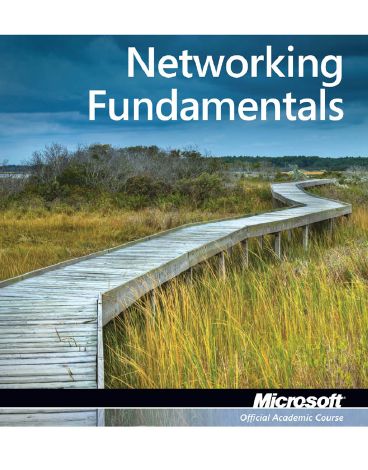

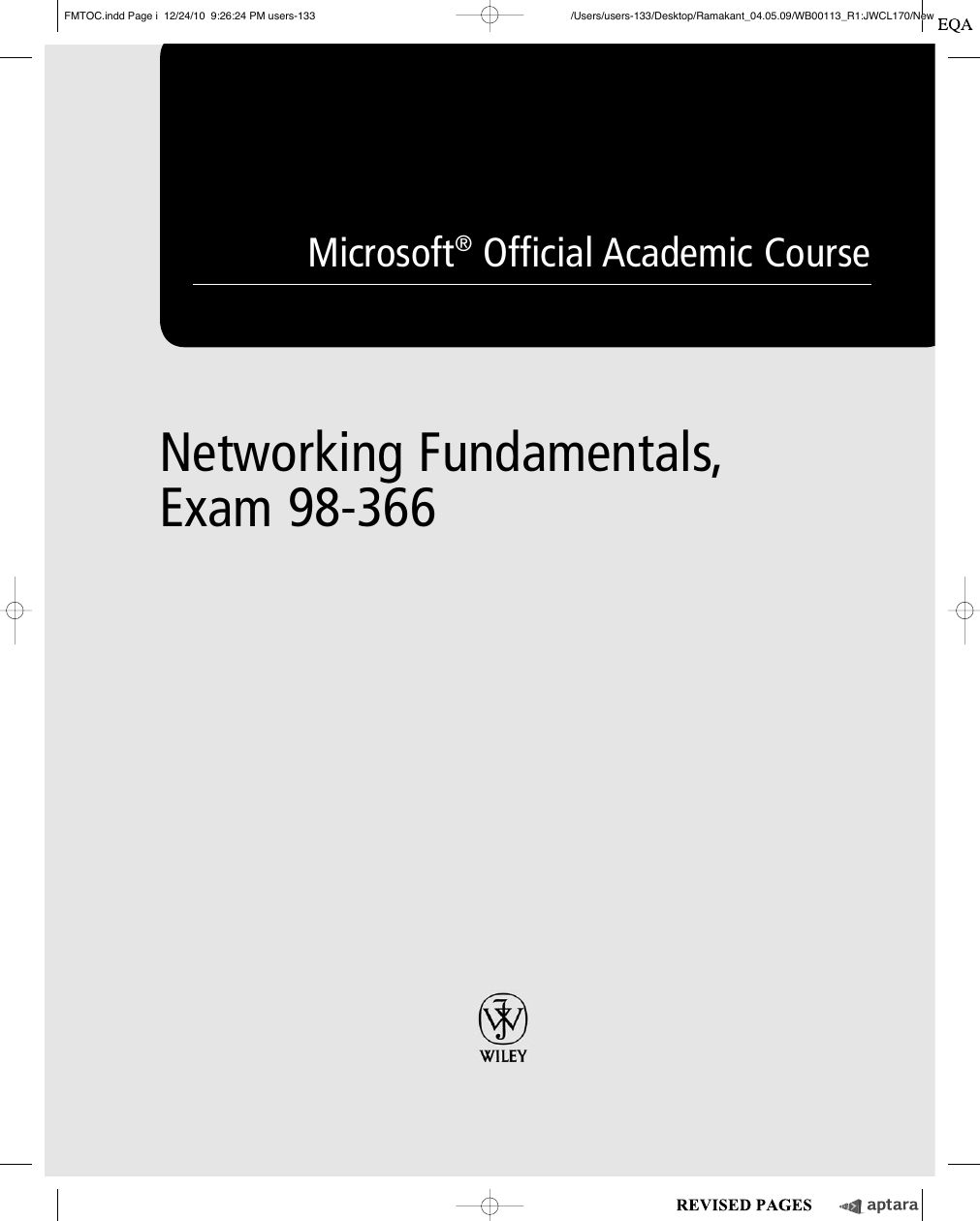
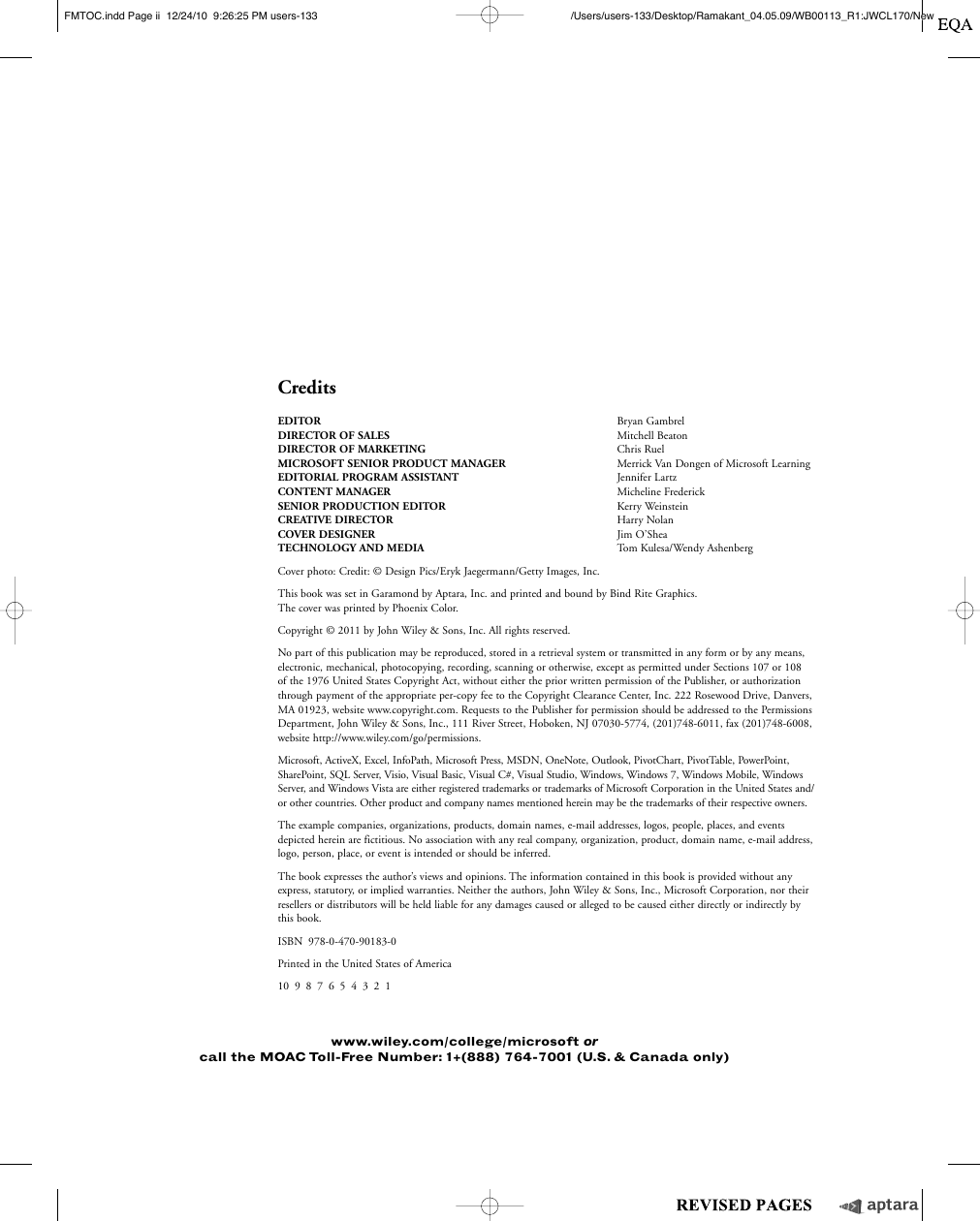
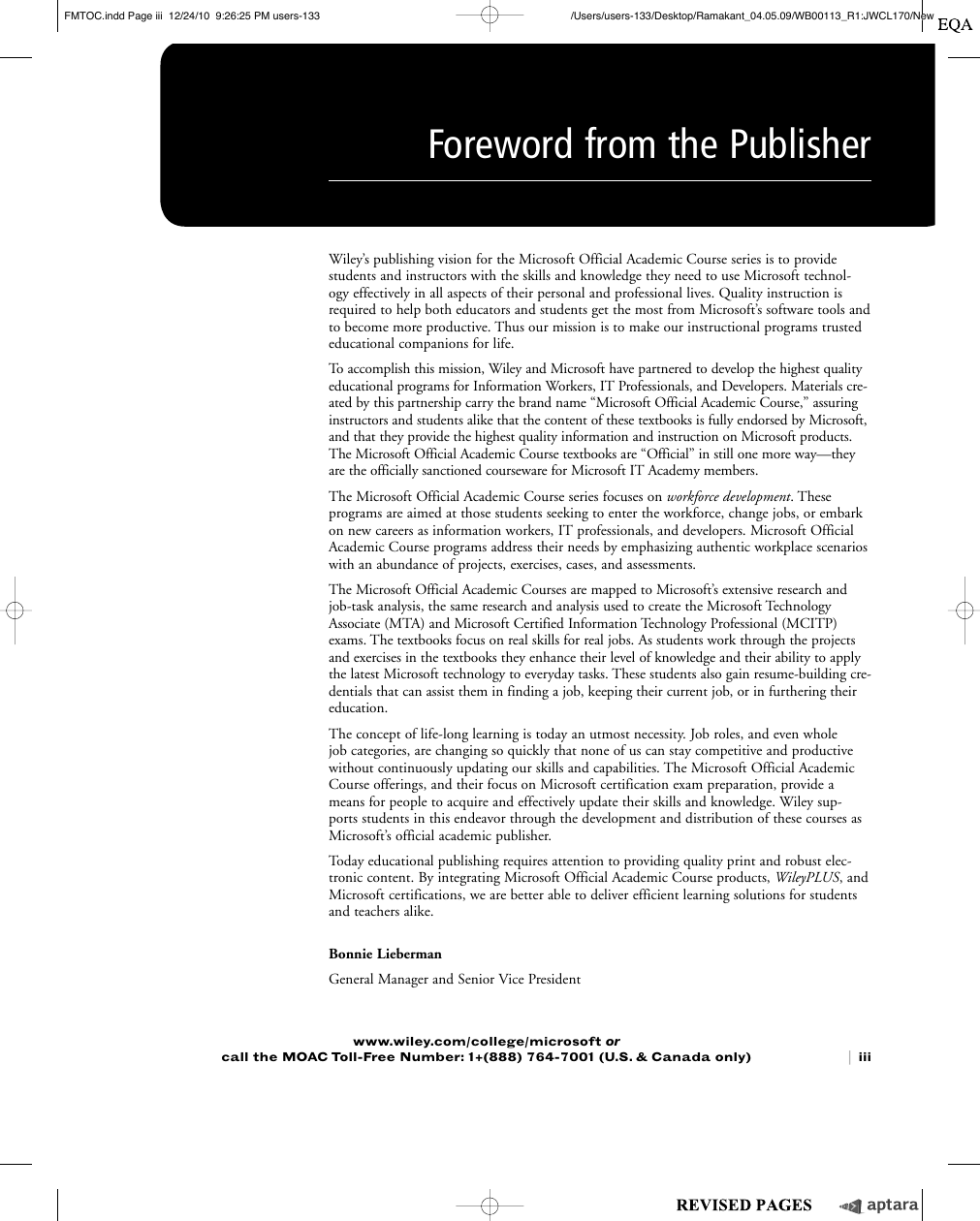
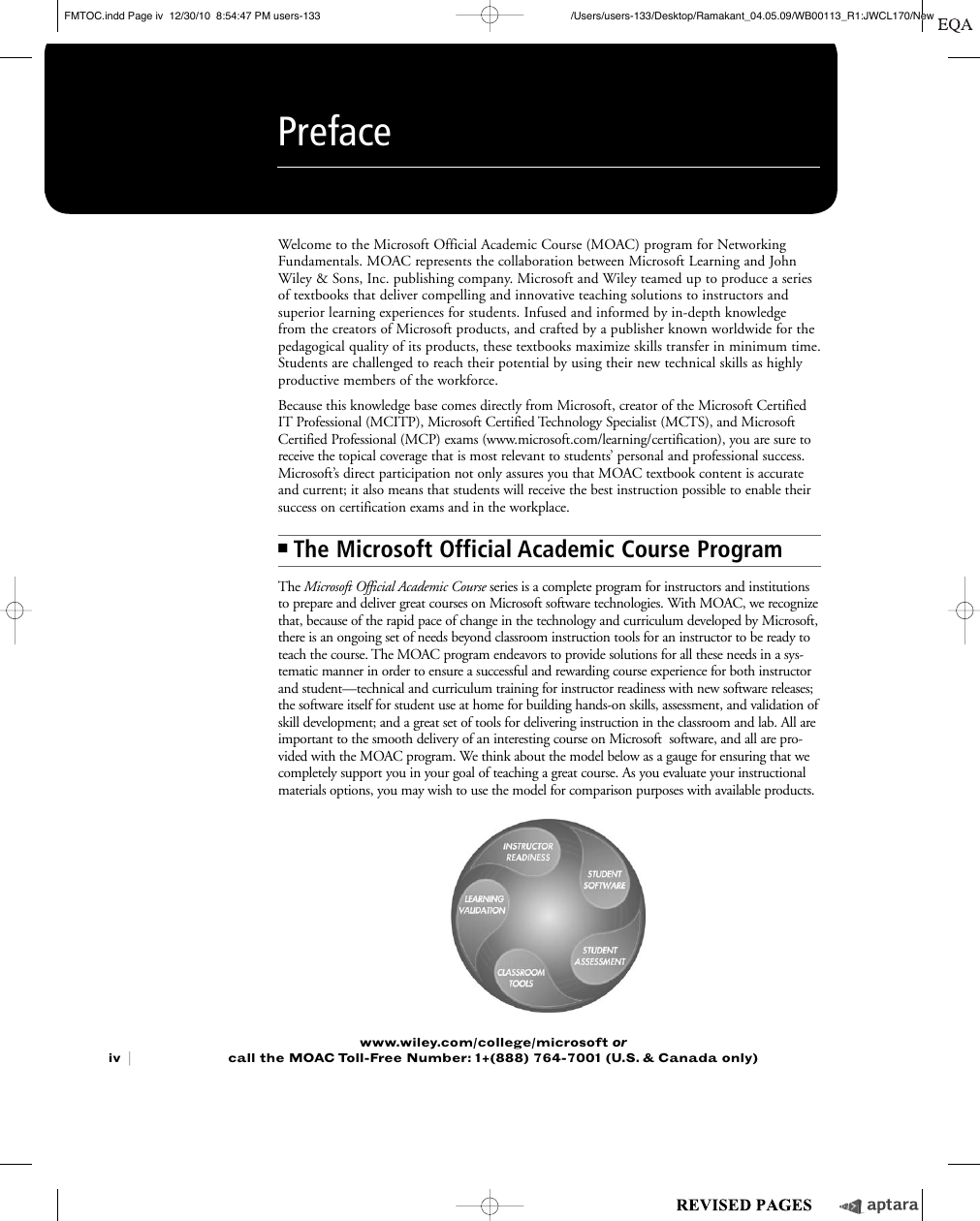
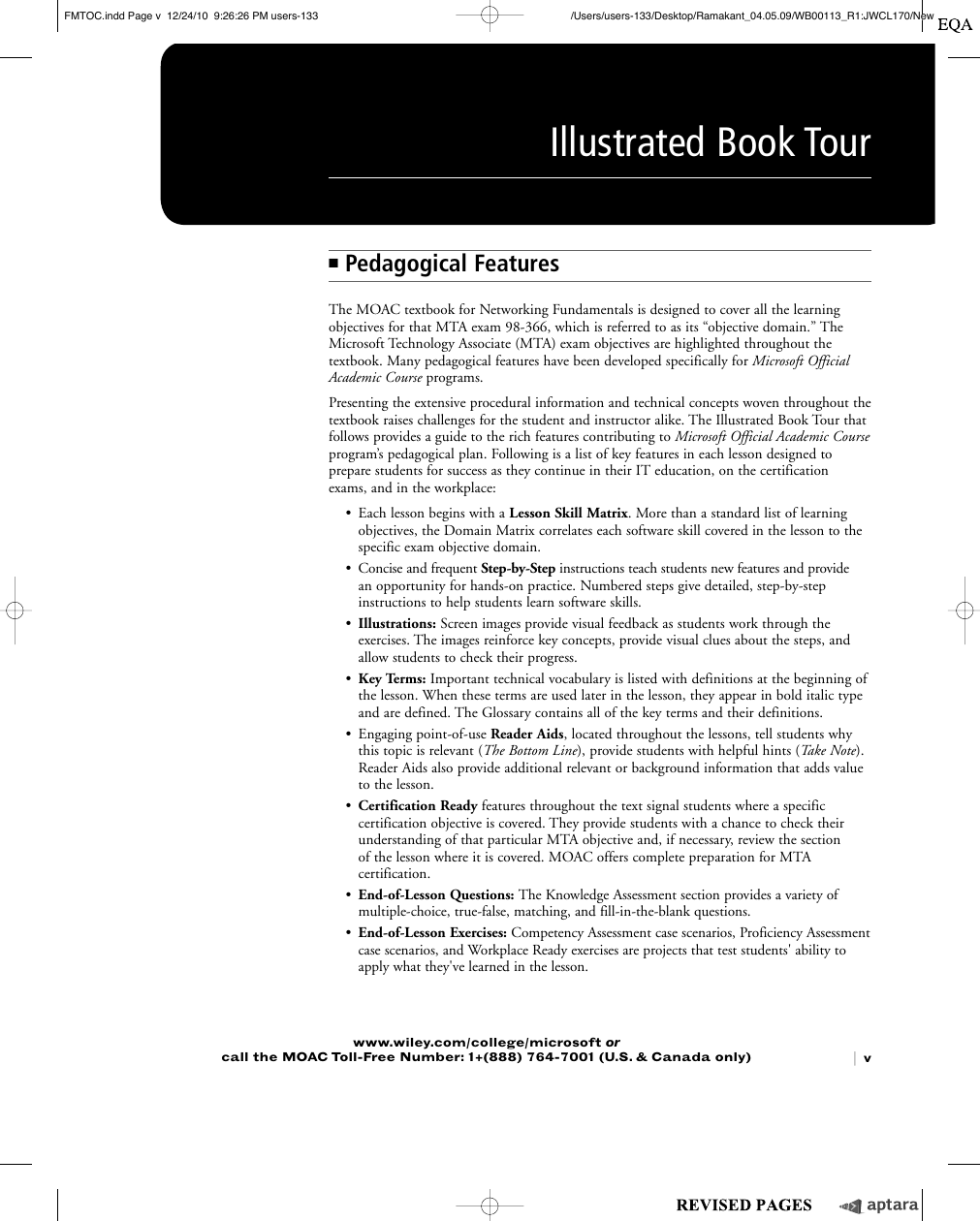
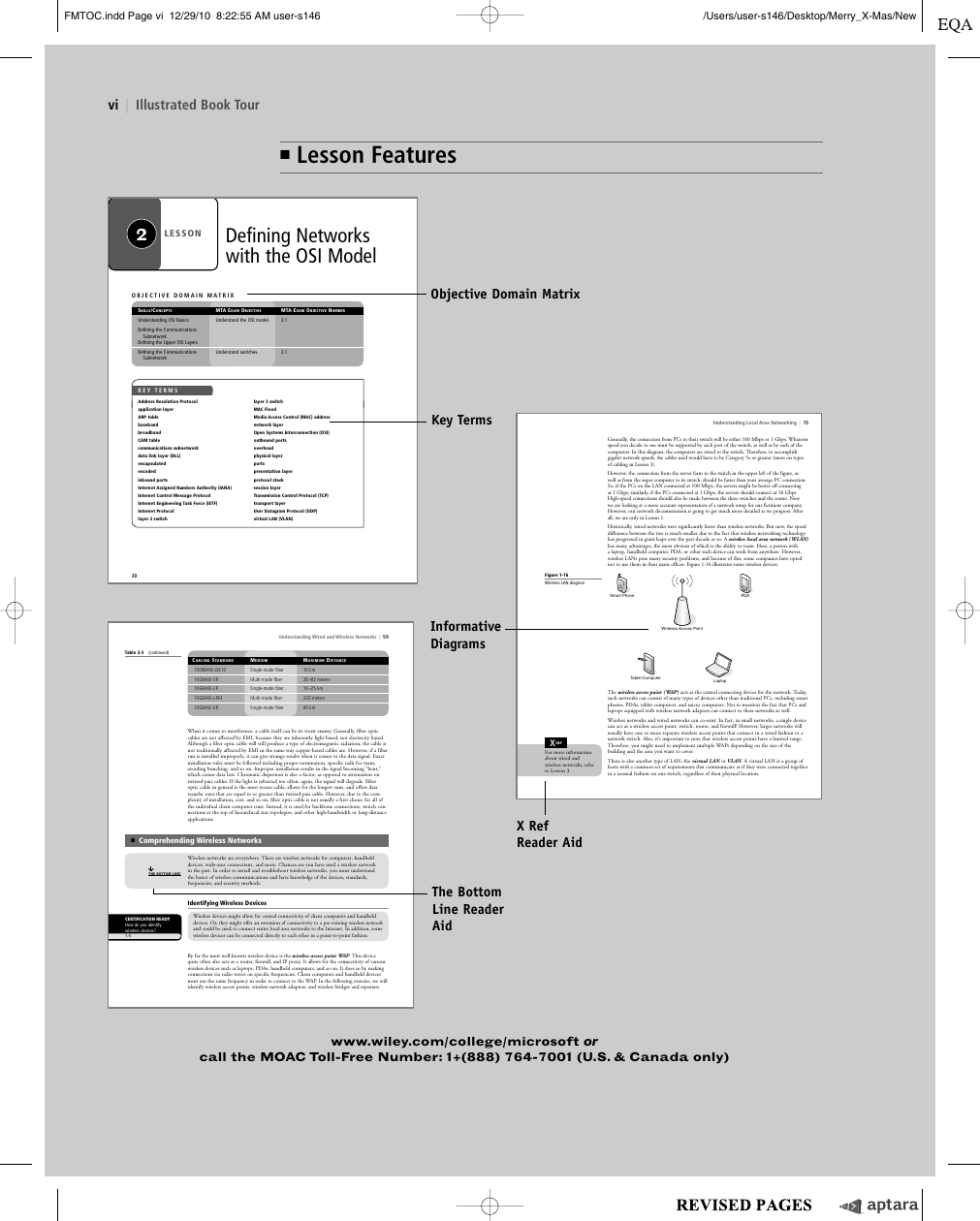








 2023年江西萍乡中考道德与法治真题及答案.doc
2023年江西萍乡中考道德与法治真题及答案.doc 2012年重庆南川中考生物真题及答案.doc
2012年重庆南川中考生物真题及答案.doc 2013年江西师范大学地理学综合及文艺理论基础考研真题.doc
2013年江西师范大学地理学综合及文艺理论基础考研真题.doc 2020年四川甘孜小升初语文真题及答案I卷.doc
2020年四川甘孜小升初语文真题及答案I卷.doc 2020年注册岩土工程师专业基础考试真题及答案.doc
2020年注册岩土工程师专业基础考试真题及答案.doc 2023-2024学年福建省厦门市九年级上学期数学月考试题及答案.doc
2023-2024学年福建省厦门市九年级上学期数学月考试题及答案.doc 2021-2022学年辽宁省沈阳市大东区九年级上学期语文期末试题及答案.doc
2021-2022学年辽宁省沈阳市大东区九年级上学期语文期末试题及答案.doc 2022-2023学年北京东城区初三第一学期物理期末试卷及答案.doc
2022-2023学年北京东城区初三第一学期物理期末试卷及答案.doc 2018上半年江西教师资格初中地理学科知识与教学能力真题及答案.doc
2018上半年江西教师资格初中地理学科知识与教学能力真题及答案.doc 2012年河北国家公务员申论考试真题及答案-省级.doc
2012年河北国家公务员申论考试真题及答案-省级.doc 2020-2021学年江苏省扬州市江都区邵樊片九年级上学期数学第一次质量检测试题及答案.doc
2020-2021学年江苏省扬州市江都区邵樊片九年级上学期数学第一次质量检测试题及答案.doc 2022下半年黑龙江教师资格证中学综合素质真题及答案.doc
2022下半年黑龙江教师资格证中学综合素质真题及答案.doc